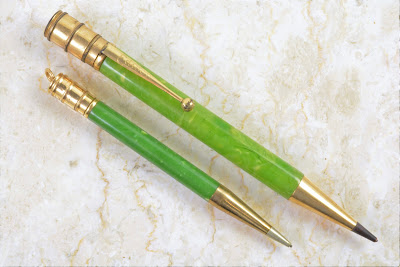This article has been edited and included in The Leadhead's Pencil Blog Volume 5; copies are available print on demand through Amazon here, and I offer an ebook version in pdf format at the Legendary Lead Company here.
If you don't want the book but you enjoy this article, please consider supporting the Blog project here.
For starters:
This one is marked “Conjeco” on the clip:
And it has the August 4, 1925 patent date on the upper section:
This one slipped into the dead letter office because I could make neither heads nor tails of the name . . . until I was researching the “Manjeco” the other day, which was a contraction of the Manufacturing Jewelers Company (see http://leadheadpencils.blogspot.com/2017/07/the-manjeco.html), and I wondered whether this might be something along the lines of “Consolidated Jewelers’ Company.” The only reference I could find to the company comes in what google calls a snippet view from The Jewelers’ Circular in 1924 – but the index listing shows more than the view itself:
The next Rex pencil I've got to show you is the larger of the two in this next picture:
Both are marked “Edison,” and I’m only counting the larger one as one of my three interesting pencils today, since I’ve already written about the ringtop (see http://leadheadpencils.blogspot.com/2015/01/two-out-of-four-horsemen-aint-bad.html):
The larger has the “four horsemen” patents on the top, indicating later production:
But what makes it noteworthy to me is the great imprint on the clip:
Unlike the block type found on the imprint, the full-sized version has Edison’s trademarked logo, which is included in American Writing Instrument Trademarks 1870-1953:
From this we know that at least in 1920, when the trademark application was filed, the president of the Edison Pen Company was George S. Bernard, and the company was already located in Petersburg, Virginia. It was also the only trademark Bernard ever filed.
My third interesting Rex (for now) is this one:
It’s marked on the barrel: “Laughlin / Detroit, Mich.”
It’s a bit earlier than the other two I’ve shown you today, stamped with McNary’s original patent of February 19, 1924:
As with the Edison, I’ve written about the Laughlin before – in fact, I’ve written about a pencil nearly identical to this one (see http://leadheadpencils.blogspot.com/2013/04/the-long-awaited-laughlin-article.html). However, what interested me about this one was a unique bit of stamping I haven’t run across before:
“Pat. Pend.” conspicuously stamped on the top side of the clip.













No comments:
Post a Comment